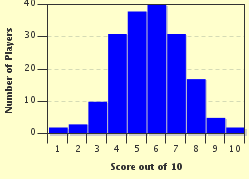Quiz Answer Key and Fun Facts
1. Of the two known sub-species of giraffe, this photo depicts the reticulated giraffe.
2. The plumage on this retreating fellow most closely resembles the marking of which well-known breed of chicken?
3. Why do ducks stick their heads under water?
4. What breed of dog, much loved by Queen Elizabeth, sometimes sports heart shapes on its derriere?
5. This creature is commonly found in Central Europe and the British Isles. What is it?
6. Whose colorful derriere is displayed in this photo?
7. About how much does a peacock's fabulous tail weigh?
8. The tail in this photo has no bones.
9. A tail that can wrap around a branch and hang on is called what?
10. This tail has an unusual name. What is it?
Source: Author
austinnene
This quiz was reviewed by FunTrivia editor
Tizzabelle before going online.
Any errors found in FunTrivia content are routinely corrected through our feedback system.


